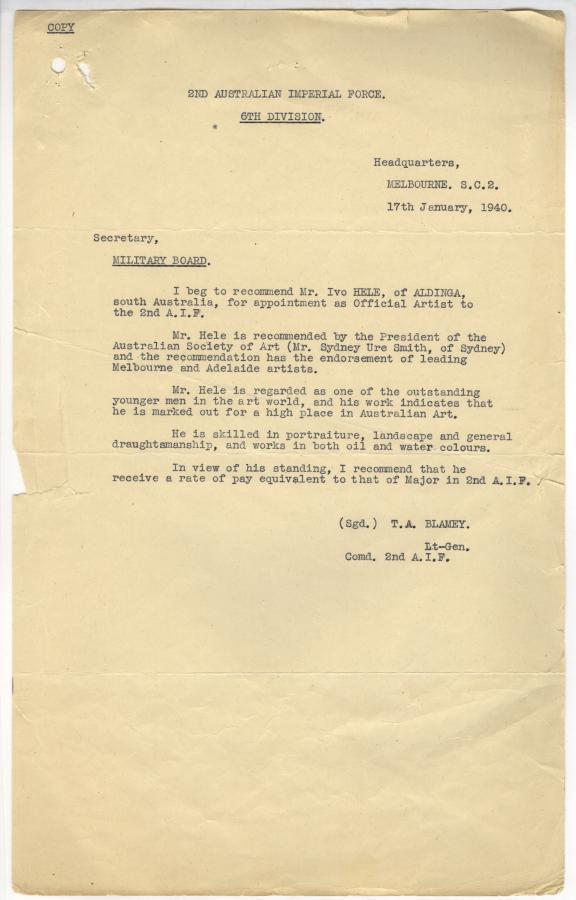The Appointment of Official War Artist Ivor Hele
Ivor Hele sketching in New Guinea. Photograph by Colin Thomas Halmarick. AWM083629
Ivor Henry Thomas Hele enlisted in the Australian Imperial Force (AIF) on 29 June 1940, hoping to be appointed an official war artist. He enlisted under the encouragement of Louis McCubbin, an official war artist of the First World War, who was then the Director of the Art Gallery of South Australia and a member of the Art Committee of the Australian War Memorial.
Hele enlisted as a private in the 2/48th Battalion. Not long after arriving in the Middle East, he met with General Sir Thomas Blamey and in January 1941 was allotted for duty as an official war artist of the AIF. Promoted to lieutenant, he was sent to cover operations in Libya.

Letter recommending Ivor Hele as an official war artist. RCDIG1066885
His appointment differed to that of other official war artists. Hele was already an enlisted member of the AIF, rather than being appointed by the Department of Information or the War Memorial Board. This difference was most clearly reflected in his conditions. Rather than receiving the usual rate of pay of two guineas per day, he was paid according to his military rank. All works he completed were to become property of the Commonwealth, and he was given the freedom to move within the field, a flexibility not afforded to other official war artists.
Being paid directly by the army was not without its pitfalls. The army did not recognise Hele’s purchase of art supplies as being authorised, and debited the cost from his pay. This left Hele “more or less stranded as regards to money.” It took numerous letters from Louis McCubbin and others before he was re-credited.

Letter detailing Hele’s problems purchasing art supplies. RCDIG1066886
After recommending Hele as an official war artist, General Blamey took an interest in his progress, with a report to the Minister for the Army giving a less than favourable view in August 1941: “I regret to say that I am tremendously disappointed in him [Hele]. He, no doubt, is an excellent artist, but it does not seem possible to get him to apply himself seriously. He is full of complaints and excuses.”
This sentiment was echoed by John Treloar, head of the Department of Information, who took charge of the Military History Section at Army Headquarters: “He possesses great talent but has been somewhat confused … On the whole he has hardly done himself justice. His idea of how he should work what that he should spend some time in the field, making mental notes and return to his studio to paint his pictures … Captain Hele has done a few works in the field and it may be found that these are the best he has done.”
Anxious to return to Australia, Hele longed for the quiet of his studio, where materials were more readily accessible, away from the challenging conditions of the field. It was agreed he should return, arriving safely back in Australia in April 1942. The same, however, cannot be said for his works. Cases of pictures were damaged at Suez en-route to Australia.

Report on Captain Hele’s art. RCDIG1066886
In Australia, Treloar and official war artist Frank Norton were on hand to unpack the damaged works and undertake remedial conservation as best they could. Some works were undamaged, others not as bad as feared, but “practically all” of the drawings were reported as “ruined” – a great loss to Hele and the Memorial.
Back in his studio in Adelaide, Hele painted the work he is perhaps best known for as an official war artist: Australian troops disembarking at Alexandria after the evacuation of Greece. Drawing on his observations in Alexandria after the evacuation of Greece, Hele’s expansive painting depicts exhausted Australian soldiers, each figure painted with dedication in his careful composition.
Ivor Hele, Australian troops disembarking at Alexandria after the evacuation of Greece, oil on canvas, unframed: 136.9 x 206 cm, 1943, ART22230
The Memorial holds more than 300 works from Ivor Hele’s service in the Second World War. His exceptional talent for figure work is evident in his sketches, studies and paintings. He faithfully captured many activities of Australian servicemen, often in difficult conditions. Hele went on to become Australia’s longest serving official war artist, serving during the Korean War.
The Australian War Memorial registry files for the application and appointment of Ivor Hele as official war artist in the Second World War have been digitised. View the digitised registry files.






